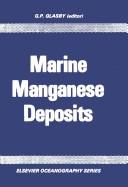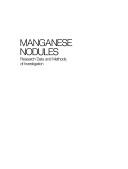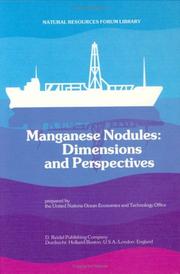| Listing 1 - 10 of 27 | << page >> |
Sort by
|
Book
ISBN: 2222024633 Year: 1979 Volume: 289 Publisher: Paris : Éditions du C.N.R.S.,
Abstract | Keywords | Export | Availability | Bookmark
 Loading...
Loading...Choose an application
- Reference Manager
- EndNote
- RefWorks (Direct export to RefWorks)
Manganese nodules --- Congresses --- Nodules polymétalliques. --- Manganèse. --- Manganese nodules. --- Manganese.

ISBN: 0444415246 9786611772314 1281772313 0080870511 9780444415240 9780080870519 Year: 1977 Volume: 15 Publisher: Amsterdam ; New York : New York : Elsevier Scientific Pub. Co. ; distributors for the U.S. and Canada, Elsevier/North-Holland,
Abstract | Keywords | Export | Availability | Bookmark
 Loading...
Loading...Choose an application
- Reference Manager
- EndNote
- RefWorks (Direct export to RefWorks)
Marine Manganese Deposits
Manganese nodules --- Deep-sea manganese nodules --- Manganese ores --- Marine mineral resources --- Marine sediments --- Manganese nodules.

ISBN: 0306651866 Year: 1979 Publisher: New York : IFI/Plenum,
Abstract | Keywords | Export | Availability | Bookmark
 Loading...
Loading...Choose an application
- Reference Manager
- EndNote
- RefWorks (Direct export to RefWorks)
Manganese nodules --- Nodules polymétalliques. --- Manganèse --- Ressources minérales sous-marines. --- Manganese nodules. --- Manganese ores. --- Marine mineral resources. --- Minerais.
Book
Year: 1975 Publisher: Washington U.S. Govt. Print. Off
Abstract | Keywords | Export | Availability | Bookmark
 Loading...
Loading...Choose an application
- Reference Manager
- EndNote
- RefWorks (Direct export to RefWorks)
Book
ISBN: 9789264090996 Year: 2018 Publisher: Paris : OECD Publishing,
Abstract | Keywords | Export | Availability | Bookmark
 Loading...
Loading...Choose an application
- Reference Manager
- EndNote
- RefWorks (Direct export to RefWorks)
The Local Lymph Node Assay: BrdU-ELISA (LLNA:BrdU-ELISA) is a non-radioactive modification to the LLNA method for identifying potential skin sensitizing test substances and measuring the proliferation of lymphocytes they induce in the auricular lymph nodes. The method described in mouse is based on the use of measuring 5-bromo-2-deoxyuridine (BrdU) content, an analogue of thymidine, as an indicator of this proliferation. A minimum of four animals is used per dose group, with a minimum of three concentrations of the test substance, plus a concurrent negative control group and a positive control group. The experimental schedule is during 6 days. Thereafter, the animals are killed and a single cell suspension of lymph node cells (LNC) is prepared. The procedure for preparing the LNC is crucial, in particular for the small lymph nodes in NC animals. Then the BrdU content in DNA of lymphocytes is measured by ELISA using a commercial kit of by Flow Cytometry (FCM). This study includes: measurements (weighing, BrdU) and clinical daily observations. The results are expressed as the Stimulation Index (SI) obtained by calculation from the mean BrdU labelling index. The SI should be ≥1.6 for the ELISA method or ≥2.7 for the FCM method for identifying the test material as a potential skin sensitizer.
Lymph Nodes --- Lymph glands --- Lymph nodules --- Nodes, Lymph --- Nodules, Lymph --- Nodus lymphaticus --- Lymphatics --- Lymph nodes.
Book
ISBN: 9789264090972 Year: 2010 Publisher: Paris : OECD Publishing,
Abstract | Keywords | Export | Availability | Bookmark
 Loading...
Loading...Choose an application
- Reference Manager
- EndNote
- RefWorks (Direct export to RefWorks)
The Local Lymph Node Assay: DA (LLNA: DA) is a non-radioactive modification to the LLNA method for identifying potential skin sensitizing test substances and measuring the proliferation of lymphocytes they induce in the auricular lymph nodes. The method, described in mouse (CBA/J strain), is based on measurement of the adenosine triphosphate (ATP) content by bioluminescence as an indicator of this proliferation. A minimum of four animals is used per dose group, with a minimum of three concentrations of the test substance, plus a concurrent negative control group and, if appropriate, a positive control group. The experimental schedule is during 8 days. The time from animal sacrifice to measurement of ATP should not exceed 30 min. The procedure from excision of lymph nodes to ATP measurement should be kept uniform for each animal and completed within 20 minutes. The luciferin/luciferase method is applied to measure the bioluminescence in Relative Luminescence Units (RLU). This study includes: measurements (weighing, RLU), and clinical daily observations. The results are expressed as the Stimulation Index (SI) obtained by calculation. The SI should be ¡Ý1.8 before further evaluation of the test material as a potential skin sensitizer is warranted.
Lymph nodes --- Lymph glands --- Lymph nodules --- Nodes, Lymph --- Nodules, Lymph --- Nodus lymphaticus --- Lymphatics --- Lymph nodes.

ISBN: 9027705003 9027709025 Year: 1979 Volume: 2 Publisher: Dordrecht : D. Reidel,
Abstract | Keywords | Export | Availability | Bookmark
 Loading...
Loading...Choose an application
- Reference Manager
- EndNote
- RefWorks (Direct export to RefWorks)
Manganese industry --- Manganese nodules --- Congresses --- 622 --- Mining --- Congresses. --- 622 Mining --- Deep-sea manganese nodules --- Manganese ores --- Marine mineral resources --- Marine sediments --- 622 Mijnbouw --- Mijnbouw --- GEOLOGIE APPLIQUEE --- GISEMENTS --- ECONOMIE --- SYSTEMATIQUE GROUPES MINERAUX --- SCIENCES GEOGRAPHIQUES --- GEOGRAPHIE INDUSTRIELLE ET MINIERE --- PROSPECTION GISEMENTS
Book
ISBN: 1461479584 1461479592 Year: 2013 Publisher: New York : Springer Science,
Abstract | Keywords | Export | Availability | Bookmark
 Loading...
Loading...Choose an application
- Reference Manager
- EndNote
- RefWorks (Direct export to RefWorks)
Atlas of Lymph Node Pathology reviews the histopathology of nodal diseases, illustrating the use of ancillary studies and includes concise discussions of pathogenesis, clinical settings and clinical significance of the pathologic diagnosis. The atlas features an overview of the benign reactive processes secondary to infectious, environmental or unknown insults, as well as relevant illustrations of virtually all primary and secondary neoplasms involving lymph nodes. The atlas also includes macroscopic images of some disorders, tables that help readers understand and comprehend diseases that look alike, and diagnostic algorithms for certain groups of diseases. Authored by highly experienced pathologists, Atlas of Lymph Node Pathology is a valuable resource that illustrates the vast majority of diseases practicing pathologists, clinicians and oncologists are likely to encounter in daily practice.
Medicine --- Health & Biological Sciences --- Pathology --- Lymph nodes --- Histology, Pathological --- Diseases --- Lymph glands --- Lymph nodules --- Nodes, Lymph --- Nodules, Lymph --- Nodus lymphaticus --- Medicine. --- Oncology. --- Pathology. --- Medicine & Public Health. --- Lymphatics --- Oncology . --- Tumors --- Disease (Pathology) --- Medical sciences --- Medicine, Preventive
Book
Year: 2020 Publisher: Frontiers Media SA
Abstract | Keywords | Export | Availability | Bookmark
 Loading...
Loading...Choose an application
- Reference Manager
- EndNote
- RefWorks (Direct export to RefWorks)
This eBook is a collection of articles from a Frontiers Research Topic. Frontiers Research Topics are very popular trademarks of the Frontiers Journals Series: they are collections of at least ten articles, all centered on a particular subject. With their unique mix of varied contributions from Original Research to Review Articles, Frontiers Research Topics unify the most influential researchers, the latest key findings and historical advances in a hot research area! Find out more on how to host your own Frontiers Research Topic or contribute to one as an author by contacting the Frontiers Editorial Office: frontiersin.org/about/contact
Science: general issues --- Botany & plant sciences --- ericoid mycorrhiza --- arbuscular mycorrhiza --- symbiotic nitrogen fixation --- LysM receptor --- legume nodules --- actinorhizal symbiosis --- evolution of signaling --- symbiotic signaling
Book
Year: 2020 Publisher: Frontiers Media SA
Abstract | Keywords | Export | Availability | Bookmark
 Loading...
Loading...Choose an application
- Reference Manager
- EndNote
- RefWorks (Direct export to RefWorks)
This eBook is a collection of articles from a Frontiers Research Topic. Frontiers Research Topics are very popular trademarks of the Frontiers Journals Series: they are collections of at least ten articles, all centered on a particular subject. With their unique mix of varied contributions from Original Research to Review Articles, Frontiers Research Topics unify the most influential researchers, the latest key findings and historical advances in a hot research area! Find out more on how to host your own Frontiers Research Topic or contribute to one as an author by contacting the Frontiers Editorial Office: frontiersin.org/about/contact
Science: general issues --- Botany & plant sciences --- Nitrogen Fixation --- Nodules --- Metabolic Adjustment --- Gene Expression reprogramming --- Omics --- Signal Transduction --- Long-Range Signals --- Legume --- Rhizobia
| Listing 1 - 10 of 27 | << page >> |
Sort by
|

 Search
Search Feedback
Feedback About UniCat
About UniCat  Help
Help News
News